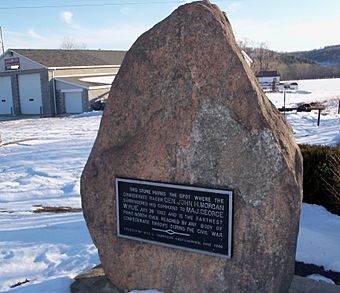John H. Morgan Surrender Site facts for kids
Quick facts for kids |
|
|
John H. Morgan Surrender Site
|
|

Monument at the site of Morgan's Surrender
|
|
| Nearest city | West Point, Ohio |
|---|---|
| Area | 0.1 acres (0.040 ha) |
| Built | 1863 |
| NRHP reference No. | 73001401 |
| Added to NRHP | April 23, 1973 |
The John H. Morgan Surrender Site is a very important historical spot in Ohio. It's where a famous event happened during the American Civil War. Here, John Hunt Morgan, a leader of the Confederate troops, gave up to the Union soldiers.
This surrender happened after a fight called the Battle of Salineville. The site is located near the small towns of Gavers and West Point in Columbiana County, Ohio. It's about 60 miles northwest of Pittsburgh, Pennsylvania. This place was added to the National Register of Historic Places in 1973 because of its military importance.
People say Morgan surrendered under a special "Surrender Tree." This spot is also famous because it was the farthest north that Confederate soldiers went into Union territory during the Civil War, except for one other event in Vermont.
Morgan's Daring Raid
In June 1863, General John Hunt Morgan led about 2,500 Confederate soldiers. Their main goal was to find new volunteers in Kentucky. They also wanted to distract a Union general named Ambrose Burnside. This would make it harder for Burnside to plan an attack on Tennessee.
Morgan's boss, General Braxton Bragg, gave him a clear order: do NOT cross the Ohio River into Union land. But Morgan decided to ignore this order.
From June 11 to July 26, 1863, Morgan's troops went on a long journey called "Morgan's Raid." They traveled from Tennessee all the way to northern Ohio. As they moved, they took supplies from the countryside. They also messed up telegraph lines and railroad tracks to slow down the Union forces.
As Morgan's Raid got closer to Columbiana County, people there became very worried. There were even rumors that his army was huge, with as many as 10,000 men! The day before Morgan surrendered, people in New Lisbon, Ohio, got ready for a fight. They heard Morgan was in Salineville, which is also in Columbiana County.
The last battle of the Raid happened around 8 a.m. on July 26. It was near the borders of Carroll, Columbiana, and Jefferson counties.
When Morgan's troops came near New Lisbon, the local militia tried to stop them. They pulled an old cannon from the Mexican War to block the road.
Around 11 a.m., a false report reached the town. It said that Morgan's rebels had beaten the militia and were coming into town. Because of this wrong information, the militia members at the cannon let Morgan's army pass without a fight. They were too scared to stop them.
The Surrender of Morgan
General Morgan met Captain James Burbeck, one of Lisbon's militia leaders, on the road. Morgan tried to surrender to Burbeck. He asked if his sick and wounded soldiers could be taken care of. He also wanted Morgan and his officers to be allowed to go home to Kentucky.
However, other Union troops led by General Rue were closing in on Morgan's army. Morgan sent an officer with a white flag to tell Rue that he had already surrendered to Burbeck.
General Rue replied that he didn't know who Captain Burbeck was. He demanded that Morgan surrender to him right away.
About an hour later, General James Shackelford arrived. He also talked with Morgan about surrendering. When Shackelford heard about Burbeck's promise to let Morgan go home, he said it was "absurd and ridiculous." He also said it was "unfair and illegal."
For the rest of his life, General Shackelford said he was the one who captured Morgan. This was because Rue was under his command. But General Rue also kept saying he was the one who captured Morgan.
In the summer of 1863, Ohio's Governor David Tod looked into Morgan's surrender. Governor Tod found out that Captain Burbeck was actually just a regular person from New Lisbon. He was not an officer in the Ohio Militia. So, Governor Tod decided that Burbeck had no power to accept Morgan's surrender. This meant Morgan's surrender to the Union forces was still valid.
Morgan and more than 60 of his officers were sent to the Ohio Penitentiary in Columbus. But on the night of November 27, 1863, Morgan and six others managed to escape from the prison. Their escape plan was thought up by Thomas Hines.




